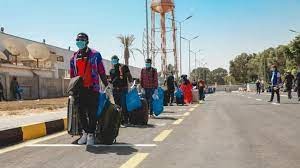The 2021 Population and Housing Census (PHC) Thematic Report on Migration has revealed that ten out of the sixteen regions had more people migrating out than migrating in with the Volta region having the largest net loss of people.
Of the six regions that had a net gain of migrants, Greater Accra had the highest gain. Further, the leading destinations for persons emigrating from Ghana to settle outside the country are Europe and America.
The report also indicates that there are gender differences in the main drivers of migration: female migrants mostly move due to marriage and family reunions whereas males move for economic reasons.
The Ghana Statistical Service (GSS) in collaboration with the International Organisation for Migration (IOM) released the report on 9th March 2023.
The programme was chaired by Mrs. Adelaide Anno-Kumi, Chief Director, Ministry of the Interior.
In her remarks, she highlighted the importance of the report and congratulated GSS for releasing statistics on migration because “the data provides the basis for planning, implementation, monitoring and evaluating and needs of the population within the context of the Sustainable Development Goals (SDGs) 10.7”.
She noted that “The Ministry of the Interior counts so much on the rich data emanating from the 2021 Population and Housing Census to address the issues relating to migration in the country to move forward with our sectorial policies and programmes.”.
She concluded with the commitment of the Ministry of the Interior to engaging further with the Statistical Service on the production of analytical reports to answer policy-relevant research questions on migration.
She urged all stakeholders, including the media to support the GSS with the effective dissemination of the 2021 PHC data for national development.
The Government Statistician, Prof. Samuel Kobina Annim, gave the opening remarks which focused on the importance of data utilisation keeping in mind the “leaving no one behind” sustainable development agenda.
He noted that Ghana in recent times has not been able to do a survey solely on migration.
He added that it was important such surveys are conducted in collaboration with Ghana Immigration Service and Ministry of Tourism, Arts and Culture, to accurately capture the issues relating to travel and tourism.
Mrs Fatou Ndiaye Diallo, Chief of Mission for Ghana, Togo, and Benin made a statement on behalf of IOM.
She stated that “Ghana requires up-to-date migration data to facilitate reporting and evidence-based policymaking as a country of origin, transit and destination.
While this has been identified as a key need by the Government of Ghana through the National Migration Policy, the achievement of this goal has proven to be a challenge”.
She commended the Statistical Service for producing the report which she said “provides the very much-needed data to interrogate the state of play of migration in Ghana to inform the right policy engineering.
Additionally, the data will support the review of the migration profile of Ghana”.
Prof. John K. Anarfi, the lead author of the Thematic Report on Migration presented the key findings from the report as highlight above.
Following his presentation, the discussant, Prof. Stephen Owusu Kwankye of the University of Ghana Regional Institute for Population Studies gave his remarks.
He discussed the policy implications of the findings and highlighting key ones such as (1) 30% of Ghanaians being classified as migrants (i.e. persons whose place of birth was different from the place of enumeration) indicating that Ghanaians are mobile and (2) the leading reason for migration being to settle permanently with 36% of migrants moving for long-term or permanent stays (3) Greater Accra leading the regions which gained population through migration, followed by Ashanti region while on the other hand, among the 10 regions which lost population through migration, the Volta region was the highest.
Source: Mybrytfmonline.com/Evans Boateng




















































